Portrait/Interview:
Nelly Ben Hayoun
Nelly Ben Hayoun is a creator of extreme experiences. She has been called ‘the Willy Wonka of design and science’ due to her unconventional, highly ambitious projects that bring together different genres. She studied Design Interactions at London’s Royal College of Art and now lectures internationally and works with a highly impressive list of clients including leading museums and design centres.
She is the Designer of Experiences at the SETI (Search for Extraterrestrial Intelligence) Institute, Head of Experiences at We Transfer, and a member of the Space Outreach and Education committee at the International Astronautical Federation. In her spare time, she is training to be an astronaut.
Her latest project, Disaster Playground, is a large, multi-platform investigation into the future outer space catastrophes and the design of procedures to manage and assess the risks of a potential asteroid of significant size hitting the earth. Sound intriguing? The London Premiere will be at the BFI on 30 June, tickets go on sale on May 12. We were lucky enough to catch her. Interview by Anna Stewart.
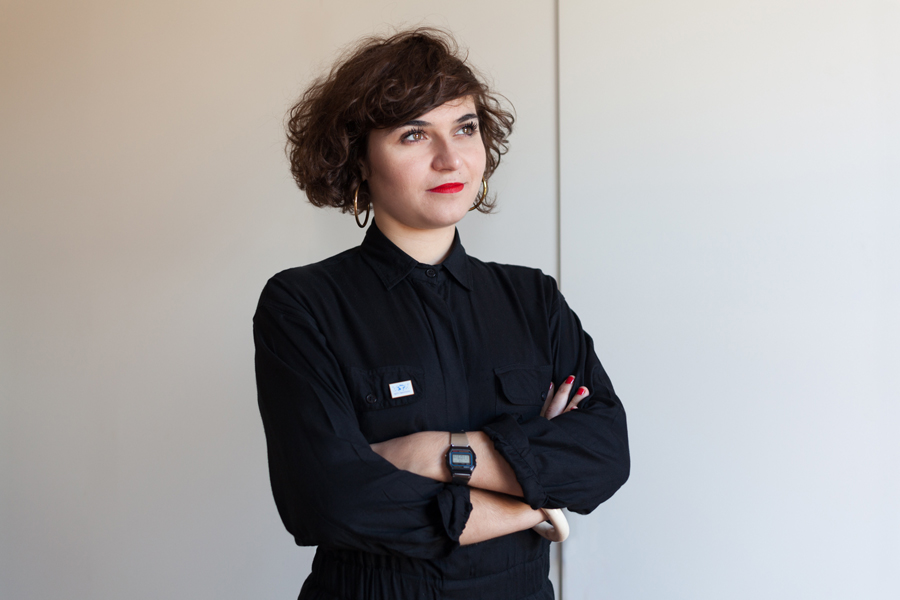
Your work is diverse: experience, design, film, aeronautics, art, science… I could go on. It’s difficult to categorise. Is there an easy way to describe what it is you do?
I design ‘extreme’ experiences for the public to access the surreal and fantastical in science. That means that I design dark energy in your kitchen sink, while a volcano erupts on your couch and you are traveling in space on board of your Soyuz Chair while being bombarded with sonic boums and neutrinos in your bathroom.
Now there are no limits to what form or shape the outcomes might take. One day it can be
a film, an other a chair, or an opera, or an installation etc… It all depends of the experience
I wish to create. One narrative can be told through various channels.
I believe that by taking an extreme approach (Antonin Artaud talked about “the theatre of cruelty” for that type of radical approach to the public) you really get the public to actively engage with a cause or with research and that is what motivates me with space exploration, for example, which is one of my fields of interest.
One key aspect of the work is also tangibility. The experiences I put together with my team
at NBH Studio will always have this component embedded in them. We work with scientists or experts in each field in which we create your experience, always. There is no point in promising you a Soyuz rocket lift off if it is according to my own belief on what it is like.
It needs to be as real as possible, therefore a big part of my time is spent finding collaborators who are willing to share their experiences so we can tailor public experiences as much as possible. In this specific case, it means working with the astronauts who have taken off from the Soyuz rocket and developing a soundtrack and everything about the experience with those individuals.
In terms of background: I come from this series of designers called critical designers, speculative designers. My mentors, Prof. Anthony Dunne and Dr.James Auger, taught me while I was at the Royal College of Art in Design Interactions. Prof. Anthony Dunne and Fiona Raby created this whole platform for design debate. Critical design aims to really push the boundaries of design and to reconsider the element of fiction. Narrative is a big part of what we do, but instead of finding answers, we generate questions. For example, how might the future of nanotechnology evolve? How might the future of synthetic biology evolve, and how might the public relate to it? So we try to generate these questions through design and creative practices.
The world of Nelly ben Hayoun sounds busy: lecturing, running a studio, PHD, talks at Google and international travel. What’s been the biggest challenge so far?
Everything is always a challenge. That is the way I roll. I get bored otherwise. I like complexity, I like huge difficult production. Everything that looks and sounds unfeasible I will want to do. Sometimes it appears impossible and in fact it never is. It is a question of organisation.
I am also very lucky to have a fantastic team of people I work with in the studio, all with various backgrounds that keep things very interesting. I work with We Transfer as their Head of Experiences and the SETI Institute (Search for Extraterrestrial Intelligence) as their Designer of Experiences and that makes things even more exiting everyday.
It is a lot of work, across different fields, but it also means that my curiosity always has enough food to think and reflect on where we are now, where we might be in the next 10 or 100 years. This makes everyday different and the creative possibilities and potentials are just endless.
What can we expect from you next – any clues?
First of all, we are releasing our latest feature film Disaster Playground on June 30th, on World Asteroid day! Check out on www.disasterplayground.com for updates. The London Premiere will be at the BFI on June 30th at 8.30pm with special guests for the Q&A, so join us for that! Tickets will be on the BFI website on May 12th. There will be additional screenings planned worldwide too, so look online.
Disaster Playground investigates future outer-space catastrophes and the procedures to manage and assess the risks. The film follows scientists who plan, monitor and deflect hazardous NEOs (Near Earth Objects) and the real-life procedures in place in the event of an asteroid collision with the earth. The film follows the chain of command running from the SETI Institute and NASA to the White House and United Nations and we meet the people who are responsible from protecting us from a potentially devastating asteroid impact.
Disaster Playground is also built as a creative platform, with a narrative told through various channels: there is a feature film, an exhibition, a concert, 13 programmes on the design of emergency procedures and debates. I like to call these mega-projects! Here is the trailer: https://vimeo.com/107466074
Also, I am currently working on something absolutely wild… something to do with the underwater world… a huge ship… and something called astrobiology… but shhhhhh…
it is secret for now! It will be out in the next 3 years! It is a new Loch Ness monster.
Hahahah!
Portrait/Interview:
Studio Dessuant Bone
Studio Dessuant Bone is a multidisciplinary design studio based in Paris run by
Marie Dessuant and Philip Bone. The couple met whilst undertaking residencies at Fabrica,
the Benetton Group Communication Centre in Italy, and have since combined their skills
to offer design consultancy that brings together branding, product and space design,
for a growing list of international clients.
Phil and Marie spoke to Anna Stewart.
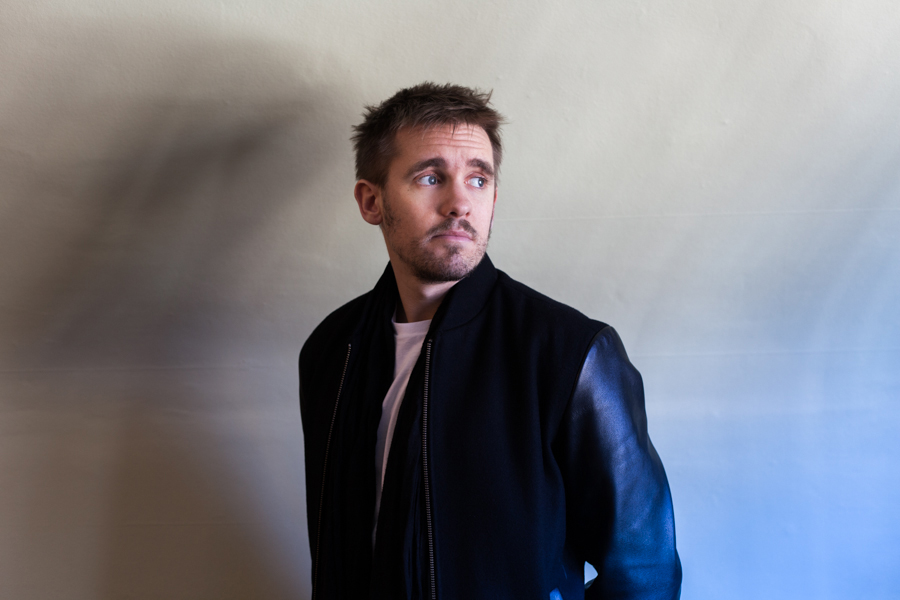
Phil Bone photographed by Amandine in London
We met during the Biennale Interieur in Kortrijk when you presented
‘The Permanent Collection’ which cleverly showed the architectural features
of an old Belgian school about to be demolished.
Can you describe the project for those who didn’t see it?
Sure, the core of the concept for The Permanent Collection was the fact that the Broel School is soon to be demolished. So we covered all the surfaces of the former classroom in the Broel School with black plastic and exposed areas of the space as if they were art, in turn highlighting, detailing, and romanticising the last moments of the space before its demolished. We used a black plastic normally associated with building and construction sites because it created a really engaging dramatic space that concentrated and focused the viewer on the negative spaces left behind. The concept also inverted the typical experience of visiting a gallery or museum, where the visitor views art displayed on the walls, in this case the old classroom was the art.
Your studio is in Paris and you both work between Paris and London.
How is the commute?! And why did you decide to settle in Paris?
We love the Eurostar, so that’s a good start! Working between the two cities is a great privilege, they are both amazing cities with their own characteristics. We find inspiration in both. London has a great buzz, energy and you can really go far there, it’s a very open, liberal city. Paris is charming, and [we] feel like there is more freedom here; it’s more suited to our personalities. After living in London for five years and visiting Paris often (it’s Marie’s home town), we were able to get a good feeling for the city and find out how the design scene and industry was developing. It felt like Paris was the perfect place to start our studio. We’ve been here for a year now and even in that short space of time there are so many new creatives here, its really exciting at the moment in Paris.
Going back to your studio… What a great space! I was lucky enough to visit
your live/work space before Maison & Objet this year. It’s very precise, thoughtful,
no clutter. Do you think your home space reflects your work, your approach to design?
To an extent yes, because there are objects, images, pieces of furniture that we like and probably reflect our personality, therefore our work, so we have them in our space.
There are also pieces of our own work however its still a working space and a home so it’s got to feel comfortable. This year we will be looking for a new studio space, hopefully we’ll find something that feels right for us, we’d love to work in a space that houses other artists, designers, photographers etc, we feel that works really well for inspiration and on a practical/professional level for networking and using other disciplines to inform our work.
I’m interested in the Honor project, a café at Comme Des Garçons on Rue du Faubourg Saint-Honore. How did this collaboration happen? And what were the challenges of designing an outdoor space like this?
We were approached by a couple of entrepreneurs who had been asked by a French coffee company called Coutume to open a new space in the courtyard of the Comme des Garçons store. It had to change the cafe landscape within the area and create a unique, creative
and enjoyable experience. It took them a while to find the right people to produce and design the project, so when we were approached we were really excited because we knew it had the potential to be a really original project. It was a great opportunity because it allowed us to design not only the space but the identity as well, in this way of working we have a holistic approach to a project, that’s something we enjoy the most.
The biggest challenge was that we knew it was outside, but it wasn’t a pop-up space,
so it had to work all year round. Also the courtyard is a listed site so the structure couldn’t be fixed to any wall or floor. This meant that we effectively moulded and ‘hugged’ the structure to the existing courtyard. To make the space work all year round the cafe was designed with a retractable roof that is transparent, maintaining the feeling of being outside; it now achieves the maximum amount of natural light during the day. The kiosk facades can be easily removed in order to create various configurations according to the weather conditions. The facades, once removed, also create architectural interests within the space, which further the design language.
(Self) Portrait/Interview:
The Interior Photographer
This week I’m the one answering questions for Ilado Paris.
I tell Anna Stewart all about what’s behind the Portrait/Interview project,
tracking the typographic potential in East London buildings for the book I published last year with architect Rute Nieto Ferreira, and a bit about motherhood and creativity.
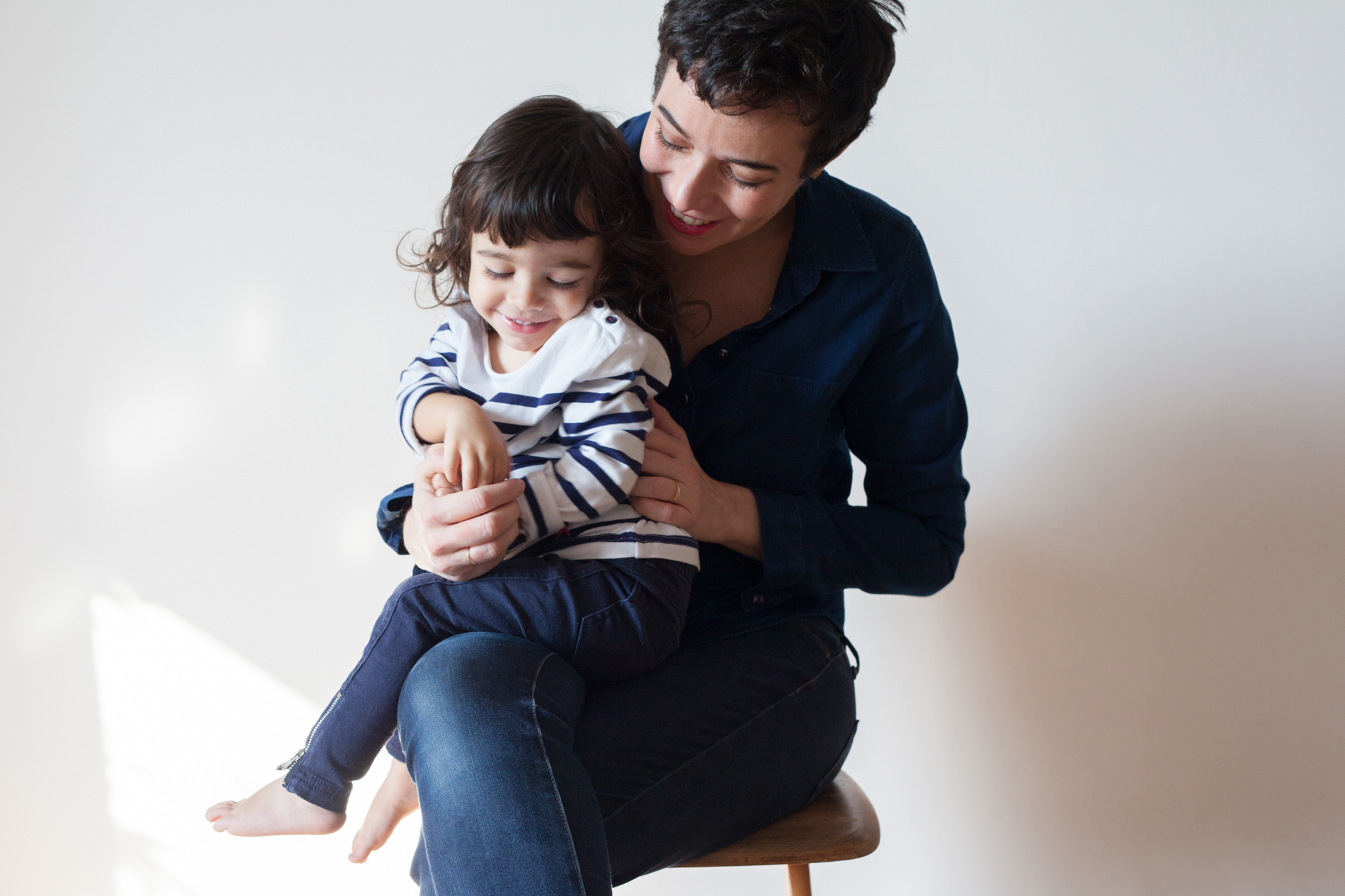
Read the interview here.
Portrait/Interview:
Liliana Ovalle
Liliana Ovalle is a London-based product designer, originally from Mexico.
Since graduating from the Royal College of Art, Liliana has worked on her chosen themes
of the incomplete, the unrehearsed, in the field of conceptual design. By maintaining her own ideas and interests, her work has become internationally sought-after and collectable.
Liliana currently exhibits at Chatsworth House in Derbyshire, part of Make Yourself Comfortable at Chatsworth, an exhibition with Thomas Heatherwick and Moritz Waldemeyer, running until October this year. She talks to Anna Stewart.
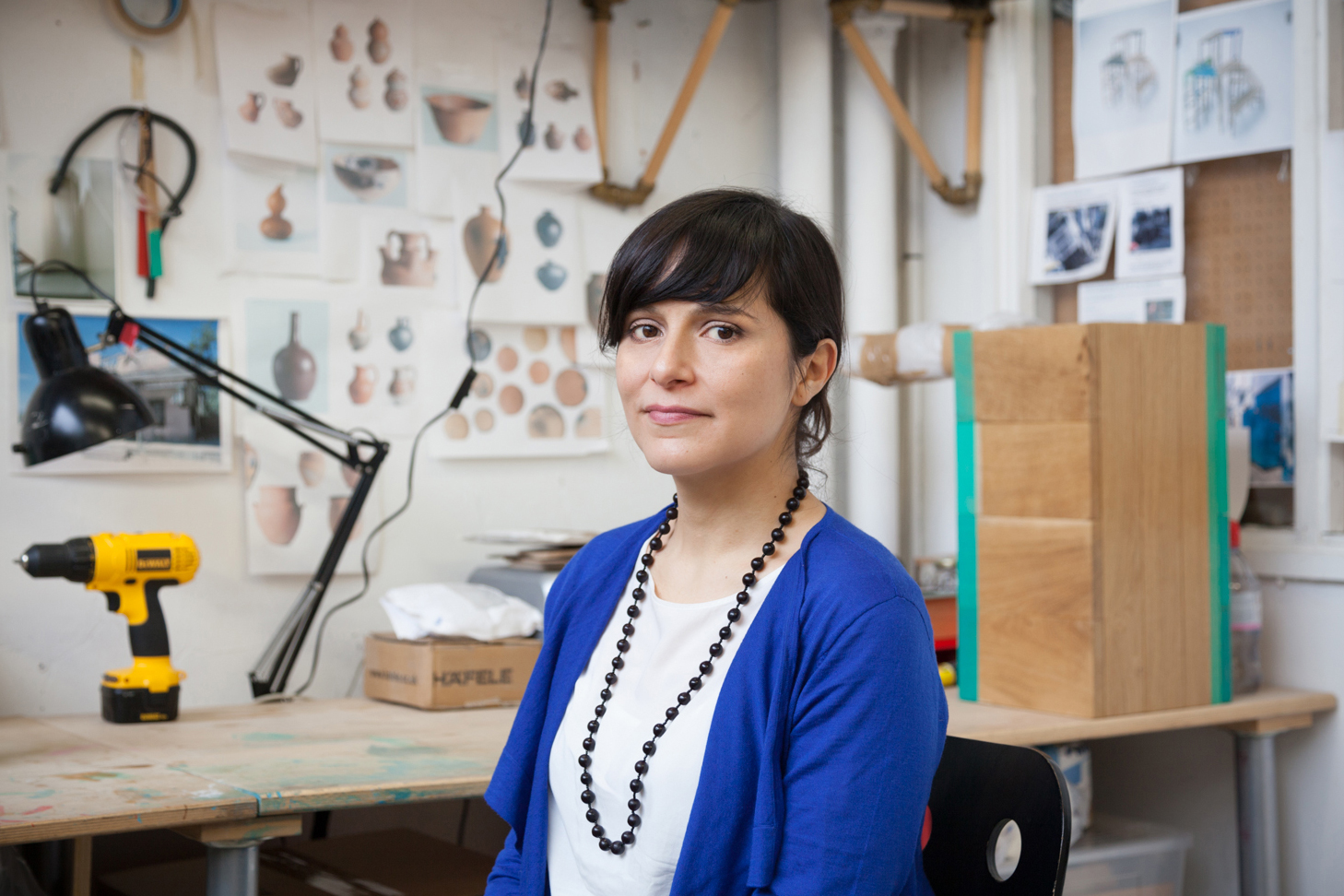
Liliana, I’m interested in your work because there’s always a lot more to your pieces than first meets the eye. One of your most intriguing projects is the red clay Sinkhole Vessels, which are now in the permanent collection of the Museum of Arts and Design in NY. Please can you explain this project in your own words?
In the past couple of years I have grown an interest in the phenomena of sinkholes.
Whenever I’ve read in the news about these unexpected voids opening at the surface
I was intrigued by the possibility of the unknown spaces lying underneath. The project was
a way of speculating about these spaces and representing them. With this in mind I contacted Colectivo 1050, a collective of artisans and designers working in Oaxaca, Mexico, a region extremely rich in vernacular culture and crafts. The shapes of the vessels were developed based on the techniques and archetypes used for local utilitarian pottery and we worked on site together to fire the pieces, achieving the dark, smoked effect. The final pieces were
finally suspended in custom wooden structures to represent a cross section of the underground voids.
It’s clear that your Mexican roots have a strong influence on all your work.
Do you spend a lot of time in Mexico? And how have these influences changed over time?
I go to Mexico once or twice year usually for very short periods, not more than 4 weeks a year. However I try to continually stay in touch and I like to use my visits as opportunities for collaborations. The relationship with my roots has certainly evolved overtime.
In my experience, when you live abroad you are constantly reconfiguring the notions you grew up with, but home always remains a central reference to making sense of the world.
I guess that my work ten years ago was a lot about understanding certain situations in the urban space that reflected cultural differences – from ad hoc assemblages to the informal use of colour. Now I am more focused on materiality. I really enjoyed working with traditional ceramics and I would like to work with other local materials.
What inspired you to create the covetable Cumulo glassware? Cumulo translates to Cumulus (as in cloud) and the pieces brilliantly work together by using the optical ‘Moiré effect’ in a simple, linear pattern. A delight.
In some of my work with textiles, including rugs and screen-printed upholstery, I had worked with linear pattern and I was always captivated by the dimensions that emerged from accidental overlapping. This interest was a combined with the research I do at Goldsmiths University where I spent some time exploring perforations and patterns for audio devices.
I looked a lot at the work of optical artists from the 60’s, such as Carlos Cruz Diez and Jesus Rafael Soto, who make an amazing use of the Moiré effect. For Cumulo I wanted the pattern to be the object itself, therefore glass was a perfect vehicle. I played with the idea of floating patterns that congregate and disperse, just like clouds. It was really interesting to me to see how a flat radial pattern could become three-dimensional.
You are part of OKAY studio, a collective of designers based in Stoke Newington, London. What do you enjoy about this collaboration with other designers and makers and how does it benefit your work?
I enjoy the company and the sense of movement in the studio, the feeling of ideas and objects taking shape. Even though we all work independently there are intersections, from exchanging the odd tip for doweling wood to an after work pint. What is interesting about the studio is that there is still a bit of the atmosphere of playground that I experienced at the RCA. It’s stimulating.
Portrait/Interview:
Michael-George Hemus, from Plumen
Michael-George Hemus is one of the founders of Plumen, a company that designs and manufactures low energy lightbulbs that are as attractive to the eye as they are energy efficient. Since their launch in 2010, Plumen has won many prestigious awards for their design and the Plumen 001 is in the permanent collection of both MoMA in NY
and the V&A in London.
I went to meet and photograph Michael-George in the Plumen studio while he spoke
to Anna Stewart.
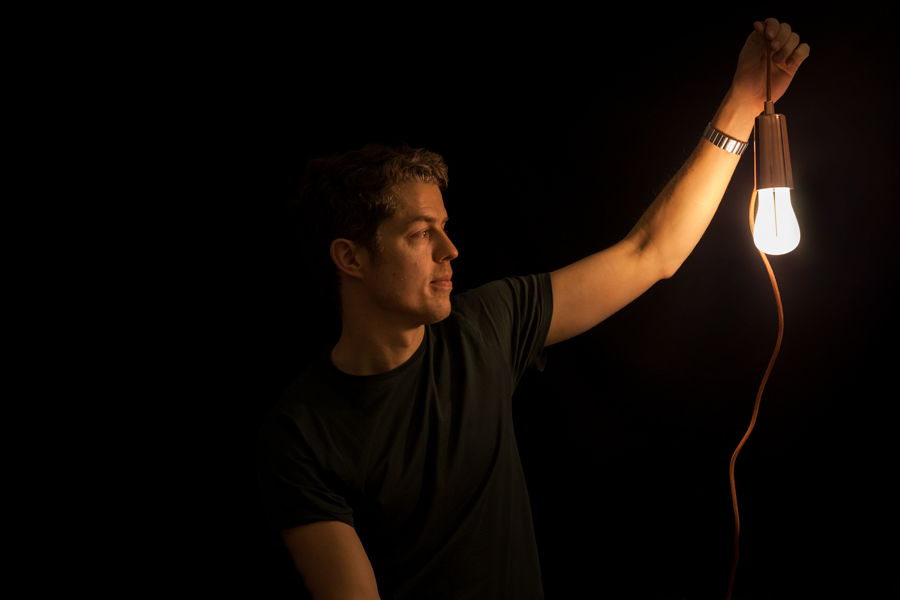
Let’s start with your role at Plumen, what’s your job here?
I am one of the founders at Plumen, there are two of us, myself and a guy called Nik Roope, and we have a third business partner called Ronnie Renton, who is our chairman. Nik is the creative director and he comes up with the creative ideas, it’s my role to run the company
on a day-to-day basis and bring the overall vision to life.
What’s most surprising to you about what you are doing now as opposed to what you expected when you were first starting out?
When we started out, we very much saw ourselves as designers and manufacturers of light bulbs and while we still focus on that, we quickly realised that we really offer decorative lighting solutions in general. We naively thought that we would make light bulbs and that people will start using them and putting them in different shades and designing around them, and it actually doesn’t work like that. We’ve needed to learn how to present the product in
the right way, so by making pendants that were designed specifically for the bulb, we now understand how these are used in the house and the same with [light] shades.
We’d never sold a light bulb before when we launched it in September 2010 so it was all very new to us. It’s been about getting feedback from stores and retailers and watching people.
All of those things lead you to further thoughts and from there we developed much more into lighting, but with still a large focus on the light source.
In terms of the designers you work with, is there anyone that you would like to work with? How does it happen, are you approaching people or do they come to you?
The way it works is that by the time we are ready to approach someone, we will already have been developing the idea for about a year, a year and a half. We will already have a very fixed idea of the design direction to take. At this point, we think about designers we know and like and whose style would be most suitable for the design challenges of the brief.
For the first bulb we knew we had two repeating forms, that they were going to be organic shapes and that we needed to work in a very tight space. Sam Wilkinson’s work was for perfect for that. Similarly for the second bulb, it was much more sculptural so we needed to work with someone who came from that angle, which is why we worked with Bertrand Clerc.
For us, a lot of the design thinking and technical work has been done already and it’s about getting the right person to help us realise the final form.
Can you say who you are working with in your future project?
We are working with a designer called Claire Norcross, who has designed a lot of lighting projects. She has created some beautiful organic folding shades, that you can see in a lot at the EAT restaurants, and she also created the beautiful ‘Ribbon’ lamp for Habitat.
One of the themes that we talk about a lot on our blog is collaboration and cross-disciplinary collaboration, is that something that is important to you as a company?
Yes definitely. For the third bulb that we are working on, there is a part on which we are working with a jeweller to help us develop the prototypes, and also because jewellers have a particular eye for light and understanding of faceting. And we have worked with lots of people from different areas, when we were producing the Hulger Phones (Plumen’s big-sister company and maker of phones used for Skype) we worked a lot with textile designers, trying to work out the patination for the holes on the mouth-piece of the phone, hence we worked with textile designers that we were sharing an office with at the time.
Obviously, we have worked with glass-blowers a lot and photographers and videographers,
to present the product. It sounds like a really basic, obvious thing but we have worked with engineers from lots of different fields to help us not just with the lighting and electronic side
of the product but with glass, with machinery and they’re not necessarily affiliated with our supplier partner.
What’s next, apart from Plumen 003?
There are other things. We have just launched light shades with made.com and we have also created our own collection, which launched roughly at the same time, called the Drop Top.
We are also looking at the world of Smart Bulbs. The idea is that via the internet of things and smart phones, all the lights in your house, or clusters of lights, can be switched on and off with the touch of a button. It allows opportunities for lighting control, which is a very big area to work with. It is an area we are exploring, and it offers a lot of opportunities for collaboration with technical and hardware experts, which then allows us to propose new approaches.